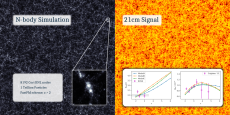Mapping Neutral Hydrogen in the Early Universe

HiddenValley simulation is employed to build models of Neutral Hydrogen in early time Universe. Left panel: dark matter with an inset of the most massive galaxy system in the field of view. Right panel: 21cm emission signal with an inset of the clustering properties compared with current constraints. Horizontal span: 1.4 comoving Gpc (6 billion light years); Thickness: 40 million light years.
Science Achievement
Researchers at the Berkeley Center for Cosmological Physics (BCCP) developed a model that produces maps of the 21cm emission signal from neutral hydrogen in the early universe. Thanks to NERSC supercomputers, the team was able to run simulations with enough dynamic range and fidelity to theoretically explore this uncharted territory which contains 80% of the observable universe by volume and holds the potential to revolutionize cosmology.
Impact
One of the most tantalizing, and promising cosmic sources is the 21 cm emission line of the hydrogen gas in the very early universe. This early time signal combines a large cosmological volume for precise statistical inference, with simple physics processes that can be more reliably modeled after the cosmic initial conditions. The model developed in this work is compatible with current observational constraints, and serves as a guideline for designing intensity mapping surveys and for developing and testing new theoretical ideas.
Research Details
The team developed a quasi-Nbody scheme that produces high-fidelity realizations of dark matter distribution of the early universe, and then developed models that connects the dark matter distribution to the 21cm emission signal from neutral hydrogen.
The simulation software FastPM was improved to run the HiddenValley simulation suite, which employs 1 trillion particles each, and utilizes 1 hour of wall clock time on 8,192 Cori KNL nodes – the largest n-body simulation ever carried out at a NERSC facility.
NERSC staff helped in many aspects for this work: securing a temporary DDT license for debugging large jobs (65536 ranks); investigating the use of MPI_Iallreduce in a key sorting routine; arranging a reservation for the initial tuning runs; diagnosing and tuning CrayMPI parameters for large jobs under high memory loads.
The maximum job concurrency was 524,288 MPI ranks on 8,192 Cori KNL nodes. Storage Space on Scratch: 100 TB. Cori KNL for simulation and postprocessing. JupyterHub for data visualization and analysis. Burst Buffer reduced the IO time of the runs, estimated improvement is 10X.
Related Links
Modi, Chirag; Castorina, Emanuele; Feng, Yu; White, Martin, "Intensity mapping with neutral hydrogen and the Hidden Valley simulations"; JOURNAL OF COSMOLOGY AND ASTROPARTICLE PHYSICS 2019 SEP, 10.1088/1475-7516/2019/09/024
About NERSC and Berkeley Lab
The National Energy Research Scientific Computing Center (NERSC) is a U.S. Department of Energy Office of Science User Facility that serves as the primary high performance computing center for scientific research sponsored by the Office of Science. Located at Lawrence Berkeley National Laboratory, NERSC serves almost 10,000 scientists at national laboratories and universities researching a wide range of problems in climate, fusion energy, materials science, physics, chemistry, computational biology, and other disciplines. Berkeley Lab is a DOE national laboratory located in Berkeley, California. It conducts unclassified scientific research and is managed by the University of California for the U.S. Department of Energy. »Learn more about computing sciences at Berkeley Lab.







